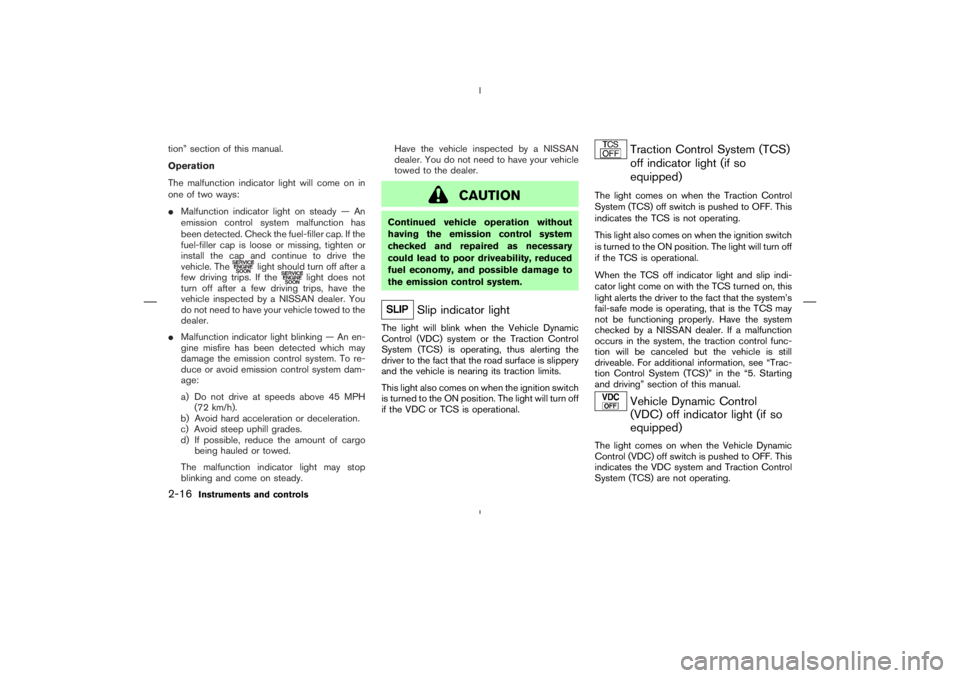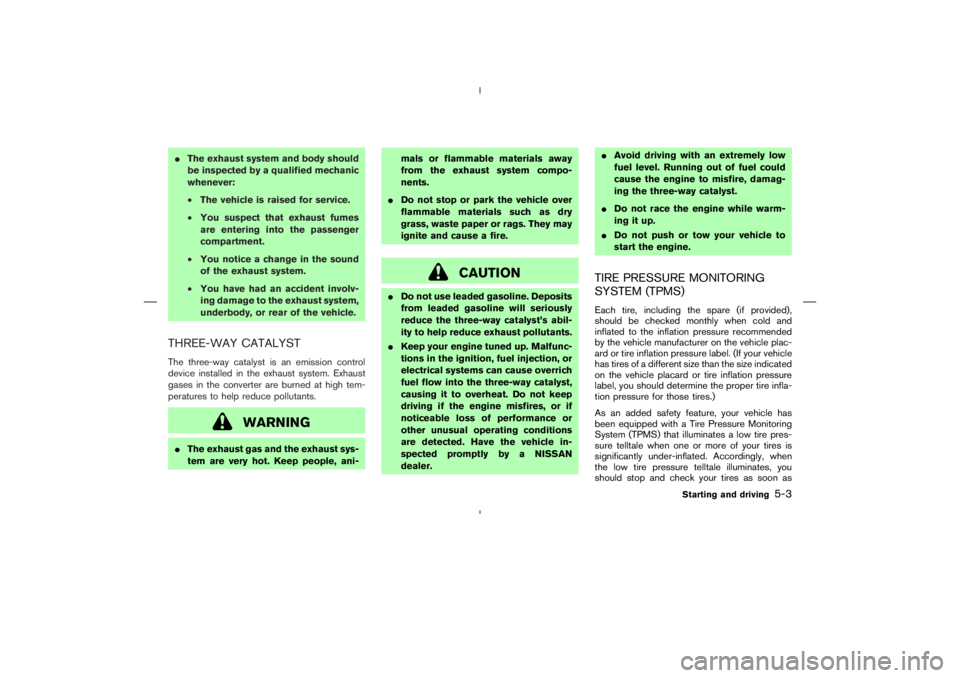Page 79 of 313

light should turn off after a
few driving trips. If the
light does not
turn off after a few driving trips, have the
vehicle inspected by a NISSAN dealer. You
do not need to have your vehicle towed to the
dealer.
�Malfunction indicator light blinking — An en-
gine misfire has been detected which may
damage the emission control system. To re-
duce or avoid emission control system dam-
age:
a) Do not drive at speeds above 45 MPH
(72 km/h).
b) Avoid hard acceleration or deceleration.
c) Avoid steep uphill grades.
d) If possible, reduce the amount of cargo
being hauled or towed.
The malfunction indicator light may stop
blinking and come on steady.Have the vehicle inspected by a NISSAN
dealer. You do not need to have your vehicle
towed to the dealer.
Traction Control System (TCS)
off indicator light (if so
equipped)
The light comes on when the Traction Control
System (TCS) off switch is pushed to OFF. This
indicates the TCS is not operating.
This light also comes on when the ignition switch
is turned to the ON position. The light will turn off
if the TCS is operational.
When the TCS off indicator light and slip indi-
cator light come on with the TCS turned on, this
light alerts the driver to the fact that the system’s
fail-safe mode is operating, that is the TCS may
not be functioning properly. Have the system
checked by a NISSAN dealer. If a malfunction
occurs in the system, the traction control func-
tion will be canceled but the vehicle is still
driveable. For additional information, see “Trac-
tion Control System (TCS)” in the “5. Starting
and driving” section of this manual.
Vehicle Dynamic Control
(VDC) off indicator light (if so
equipped)
The light comes on when the Vehicle Dynamic
Control (VDC) off switch is pushed to OFF. This
indicates the VDC system and Traction Control
System (TCS) are not operating.
2-16
Instruments and controls
Page 88 of 313
illumi-
nates.
�2Pull the lever back to select the low beam.
�3Pulling the lever toward you will flash the
headlight high beam.
Battery saver system�When the headlight switch is in the
or
position while the ignition switch is in
the ON position, the lights will automaticallyturn off 5 minutes after the ignition switch has
been turned to the OFF position.
�After the headlights automatically turn off with
the headlight switch in the
or
po-
sition, the headlights will illuminate again for 5
minutes if the headlight switch is turned to
the OFF position and then turned to the
or
position.
position.
If the parking brake is applied before the engine
is started, the daytime running lights do not
SIC3315
Instruments and controls
2-25
Page 188 of 313

CAUTION
�Do not use leaded gasoline. Deposits
from leaded gasoline will seriously
reduce the three-way catalyst’s abil-
ity to help reduce exhaust pollutants.
�Keep your engine tuned up. Malfunc-
tions in the ignition, fuel injection, or
electrical systems can cause overrich
fuel flow into the three-way catalyst,
causing it to overheat. Do not keep
driving if the engine misfires, or if
noticeable loss of performance or
other unusual operating conditions
are detected. Have the vehicle in-
spected promptly by a NISSAN
dealer.�Avoid driving with an extremely low
fuel level. Running out of fuel could
cause the engine to misfire, damag-
ing the three-way catalyst.
�Do not race the engine while warm-
ing it up.
�Do not push or tow your vehicle to
start the engine.
TIRE PRESSURE MONITORING
SYSTEM (TPMS)Each tire, including the spare (if provided),
should be checked monthly when cold and
inflated to the inflation pressure recommended
by the vehicle manufacturer on the vehicle plac-
ard or tire inflation pressure label. (If your vehicle
has tires of a different size than the size indicated
on the vehicle placard or tire inflation pressure
label, you should determine the proper tire infla-
tion pressure for those tires.)
As an added safety feature, your vehicle has
been equipped with a Tire Pressure Monitoring
System (TPMS) that illuminates a low tire pres-
sure telltale when one or more of your tires is
significantly under-inflated. Accordingly, when
the low tire pressure telltale illuminates, you
should stop and check your tires as soon as
Starting and driving
5-3
Page 223 of 313
CAUTION
�When towing, make sure that the
transmission, axles, steering system
and powertrain are in working condi-TOWING YOUR VEHICLE
6-10
In case of emergency
Page 225 of 313
CAUTION
�Tow chains or cables must be at-
tached only to the main structural
members of the vehicle or the recov-
ery hook. Otherwise, the vehicle body
will be damaged.
�Do not use the vehicle tie down
hooks to free a vehicle stuck in sand,
snow, mud, etc. Never tow a vehicle
using the vehicle tie down hooks.
�Always pull the cable straight out
from the front of the vehicle. Never
pull on the vehicle at an angle.
Page 242 of 313
CAUTION
Tampering with the strut tower bar ad-
justment may cause a noise while driv-
ing or damage to the hood or engine.
Page 278 of 313

CAUTION
�Using a fuel other than that specified
could adversely affect the emission
control system, and may also affect
the warranty coverage.�Under no circumstances should a
leaded gasoline be used, because
this will damage the three-way cata-
lyst.
�Do not use E-85 fuel in your vehicle.
Your vehicle is not designed to run
on E-85 fuel. Using E-85 fuel can
damage the fuel system components
and is not covered by the NISSAN
vehicle limited warranty.
Gasoline specificationsNISSAN recommends using gasoline that meets
the World-Wide Fuel Charter (WWFC) specifi-
cations where it is available. Many of the auto-
mobile manufacturers developed this specifica-
tion to improve emission control system and
vehicle performance. Ask your service station
manager if the gasoline meets the WWFC
specifications.Reformulated gasolineSome fuel suppliers are now producing reformu-
lated gasolines. These gasolines are specially
designed to reduce vehicle emissions. NISSAN
supports efforts towards cleaner air and sug-gests that you use reformulated gasoline when
available.
Gasoline containing oxygenatesSome fuel suppliers sell gasoline containing
oxygenates such as ethanol, MTBE and metha-
nol with or without advertising their presence.
NISSAN does not recommend the use of fuels of
which the oxygenate content and the fuel com-
patibility for your NISSAN cannot be readily
determined. If in doubt, ask your service station
manager.
If you use oxygenate-blend gasoline, please take
the following precautions as the usage of such
fuels may cause vehicle performance problems
and/or fuel system damage.
�The fuel should be unleaded and have
an octane rating no lower than that
recommended for unleaded gasoline.
�If an oxygenate-blend, excepting a
methanol blend, is used, it should con-
tain no more than 10% oxygenate.
(MTBE may, however, be added up to
15%.)
�If a methanol blend is used, it should
contain no more than 5% methanol (me-
thyl alcohol, wood alcohol). It should
also contain a suitable amount of ap-
propriate cosolvents and corrosion in-
Technical and consumer information
9-3
Page 292 of 313
CAUTION
�Do not tow a trailer or haul a heavy
load for the first 500 miles (800 km).Your engine, axle or other parts
could be damaged.
�For the first 500 miles (800 km) that
you tow a trailer, do not drive over 50
mph (80 km/h) and do not make
starts at full throttle. This helps the
engine and other parts of your ve-
hicle wear in at the heavier loads.
MAXIMUM LOAD LIMITS
Maximum trailer loadsNever allow the total trailer load to exceed 1,000
lb (454 kg). The total trailer load equals trailer
weight plus its cargo weight. Towing loads
greater than 1,000 lb (454 kg) or using improper
towing equipment could adversely affect vehicle
handling, braking and performance.
The ability of a vehicle to tow a trailer is not only
related to the maximum trailer loads, but also the
places you plan to tow. Tow weights appropriate
for level highway driving may have to be reduced
on very steep grades or in low traction situations
(for example, on slippery boat ramps).